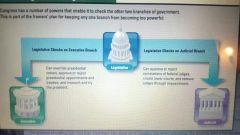![]()
![]()
![]()
Use LEFT and RIGHT arrow keys to navigate between flashcards;
Use UP and DOWN arrow keys to flip the card;
H to show hint;
A reads text to speech;
8 Cards in this Set
- Front
- Back
|
Analyze the formal and informal qualifications for members of Congress. |
Formal •Resident of state they are elected •30 years old •U.S citizen for at least 9 years Informal •Education •Occupation (used to be race and gender also) |
|
|
Identify and describe the leadership positions in Congress. |
Leadership in House Speaker of House- most power and prestige, assign bills, appoints members, decides what bills get debated Majority and Minority Leaders- elected by respected party, manage legislation on house floor, majority is 2nd in command and minority's overall leader Majority and Minority Whips- Responsible for keeping leadership informed and persuading party members to vote along party lines Leadership in Senate President of Senate- official presiding officer, assigns position to vice president, only appears for ceremonies or to break the vote President of Senate pro tempore- senior senator of majority party, may preside over senate sessions if VP isn't there, take turns presiding as the senate Majority Leader- serves as spokes person for party with the most seats, lacks ability to single-handedly make things happen, must work with party members to move legislation to vote Minority Leader- helps shape minority party policy and devise strategies for stopping majority party sponsored bills, world with majority to schedule business Majority and Minority Whips- main duty is to stand in for majority and minority leaders, duties vary depending on the needs of party leaders |
|
|
Discuss approaches to lawmaking: delegates, trustees, partisans, politicos. |
Delegates- responds to wishes of constituents Trustees- use their best judgement Partisans- party commitment Politicos- mix and match |
|
|
Explain the power of incumbency |
Name Recognition Office Resources Campaign Funds Bragging Rights |
|
|
Distinguish between different types of commitees |
Standing Commitees- permanent commitees that handle most legislative business, gather information through hearings and investigations Subcommittees- do most of the work of reviewing proposed legislation Select/Special Commitees- investigate specific problems, temporary, make recommendations to Congress based on their investigations Joint Commitees- made up of members from both the Senate and House, deal with issues of interest to both chambers Conference Commitees- formed to iron out differences between two versions of a bill passed by the House and Senate |
|
|
Identify the enumerated powers of the legislative branch and the checks provided by the Constitution to that branch on the other branches of government |

•levy taxes •borrow money •regulate interstate and foreign commerce •coin money •declare war •make all laws which shall be necessary and proper |
|
|
Determine key information about everything convening a new Congress and briefly explain how these ideas influence lawmaking. |
Meet To Choose Leaders Primary Task: First party meeting: Organize new Congress > formation of commitees > serve only on their political party > consider strategies > determine party positions Make Commitee Assignments Request seats then approve to ensure party loyalty > new members accept whatever assignments > house members stand on one commitee > control federal purse strings > deal with crucial issues First Day of a New Congress Opens with series of ceremonies > house votes on speaker > vote along party lines > majority always wins > swears in all members > VP swear in Senate |
|
|
Explain the formal process of how a bill travels through Congress including the roles of commitees. |
1. Legislation is Introduced 2. Committee Action 3. Floor Action 4. Conference Commitee 5. President - sign bill - veto bill - 10 days later... - pocket veto |

